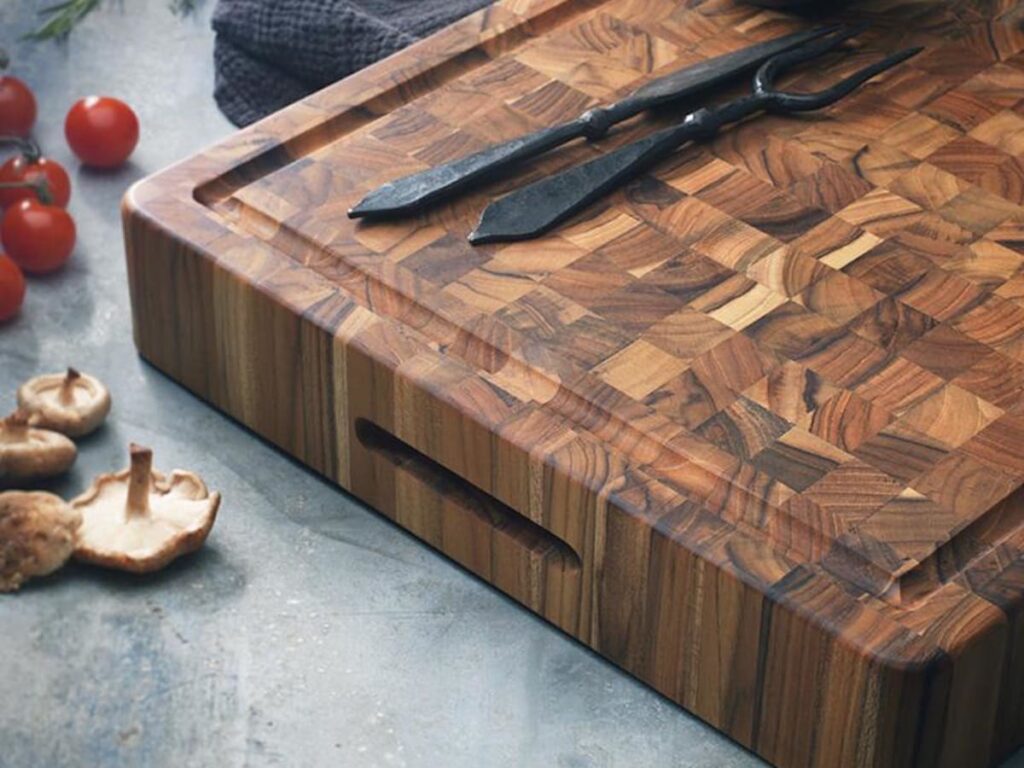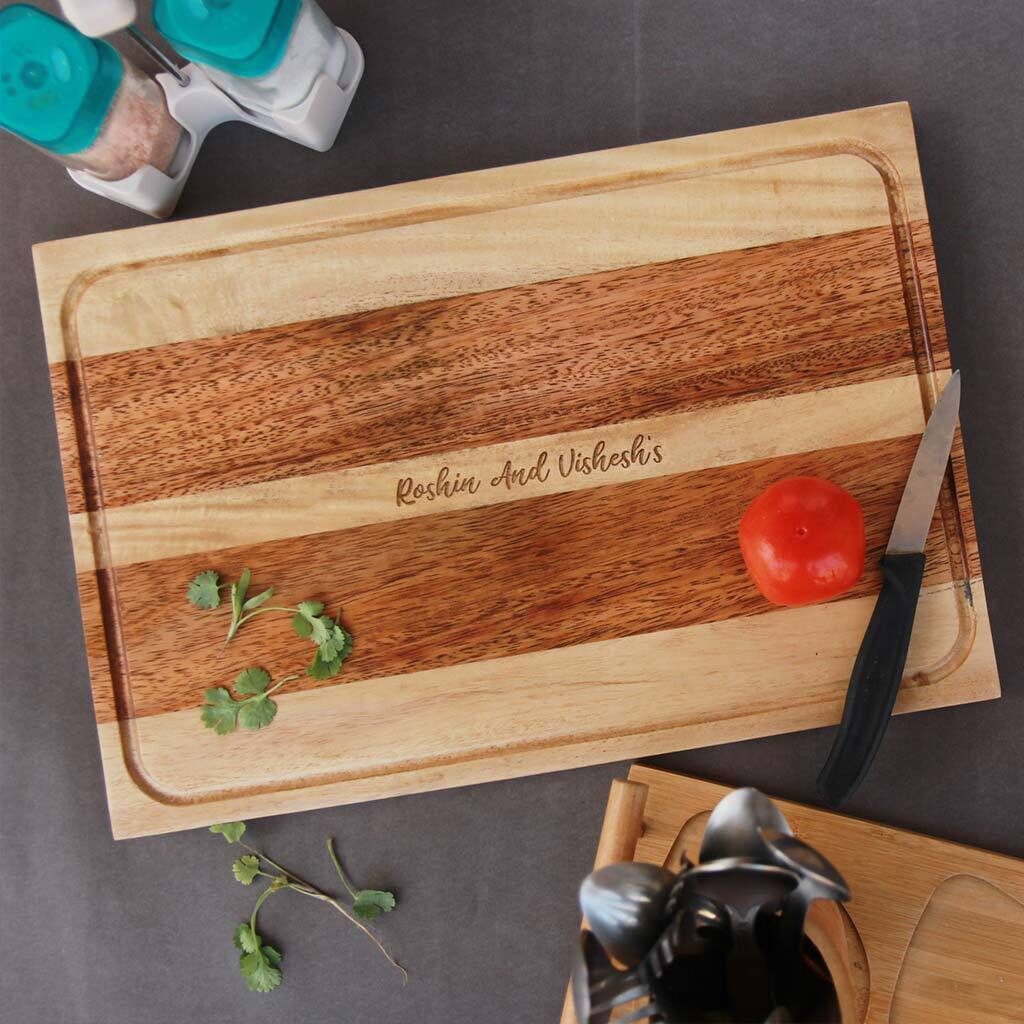A kitchen is unimaginable without a cutting board. Rarely does a meal go by without chopping, dicing, grinding or kneading. Your level of knowledge and skill around the kitchen doesn’t mean you won’t need one, it means that you know you definitely do, maybe even a few of them. Your meals, finger and kitchen countertops will thank you for it.
Even so, knowing how to choose a wooden chopping board doesn’t appear that elemental as their purpose. When it comes to humidity, cutting boards do face a lot of it during their lifetime. Hence, you should look for wooden chopping boards that can handle it. That’s why tropical woods excel at this role.
Acacia wood, for example, deserves a place in your kitchen collection due to its durability and water resistance, making it ideal for heavy-use items that are frequently in contact with liquids. Some believe it can last up to 40 years.
Not only does It not scratch easily but it also has innate antibacterial and antifungal properties, making it great for food prep. Moreover, its deep, rich and warm brown colour will add a homey vibe to any kitchen. Acacia looks mesmerising whether natural, polished or varnished.
Hevea brasiliensis or rubber tree, besides introducing us to natural rubbers and its latex sot, it’s also great for the production of environmentally friendly tropical hardwood that excels in the kitchen. Pará rubber trees have a natural defence system against airborne bacteria and mould. Tropical hardwood from a rubber tree is extremely durable and easy to clean, the 2 main criteria that allow it access to a chef’s kitchen.
Edge Grain vs. End Grain Wood Cutting Boards

Now that we have the material out of the way, it’s time to get down to business. How is it all laid down and how does the process influence the end result? If you’ve started your journey in the apt cookware and wooden chopping boards world, you have probably encountered edge grain and end grain cutting boards shortly after.
If the lateral edges of the pieces of wood are brought together in a parallel fashion you get an edge grain cutting board. Simply put, stacked pieces of wood are glued together and then cut longitudinally. As a result, you have a surface with vertical lines.
Although you can chop anything on it, it might be best suited for gentler and softer products like fruits and veggies. Firstly, chopping produces a harder and louder sound, growing proportionally with the amount of force you apply. Secondly, the direction of the microscopic fibres of the wooden board is analogous to the direction in which they can withstand most pressure.
By chopping, on the other hand, you would apply force perpendicularly. This results not only in a bigger resistance your knife will have to put up with but also possible microscopic breaks in your edge grain cutting board.
Contrary to edge grain, end grain wooden chopping boards are created by cutting the pieces of wood in the frontal plain after stacking them. This would mean you would see the end of the board instead of its side or edge as in edge grain. They’re usually round but they do come in rectangular and squared shapes and are defined by the checked design. Also, they absorb more impact, hence, chopping on an end-grain chopping board produces a softer sound.
At the end of the day, your chopping technique depends on itself and the thing that you’re cutting. You won’t be a better chef because of your wooden board, you’ll just have a better cooking experience as if that’s not enough. Your choice will finally depend on aesthetic preferences. Although both have their perks and flaws, neither choice will be a mistake.
Maintenance

Fruit, vegetables, fresh and smoked fish have been stored in wooden crates for centuries while authentic cheese- and wine-making can’t be imagined without wooden boards and barrels. In fact, wood has been safely used in contact with food for centuries and to this date, there is no evidence that any food-borne disease has been nurtured and spread by the proper use of wood.
This includes hygienic standards in all links in the supply chain, from production to storage and finally, to its application. Nevertheless, there are objections to the use of wood in direct contact with food and it’s usually considered less hygienic than synthetic materials.
Also, people are not unfamiliar with high-risk practices that create a potential for cross-contamination of foods due to inefficiently cleaned cutting boards and bacteria has been recovered. Even so, although wood that’s been in contact with food hasn’t been found responsible for any food-borne outbreak yet, it tends to be regarded as less hygienic than other materials in contact with goods in the food industry, such as plastic, stainless steel and glass. This is due to the porous nature of wood which would be difficult to disinfect. However, many kinds of wood have innate immunities ready to fight off the harm that comes their way.
A wooden cutting board should be rubbed well and washed with a dishwashing liquid and rinsed with warm water. You should always make sure it dries well, either in the open air or by wiping it with a dry and clean cloth. Others recommend cleaning chopping boards every four hours as a good hygiene practice, especially in a high-traffic kitchen.
Although the 90ties were the period of recommending plastic, authorities in the field now recommend using both types. In fact, it’s always best to use 1 cutting board for meat and 1 for fruits and vegetables, to avoid cross-contamination. This will also spare your boards from having the life cut out of them prematurely.
Last but not least, the elemental beauty and simplicity of wooden cutting boards make them so much more than chopping assistants. They’re not just key players in the functionality of your kitchen but are also enrichments of the whole dining experience you’re set to set up in your humble abode.
Whether you’re serving dips and vegetables, cheese or fruit, wooden cutting boards can help you prep your table for any type of get-together. Not only are they accessible and easy to clean but they can also complement any type of occasion. You can use them as a centrepiece for your next big family get-together or serve up your birthday muffins on beautiful, round and mellow end-grain wood cutting boards.

